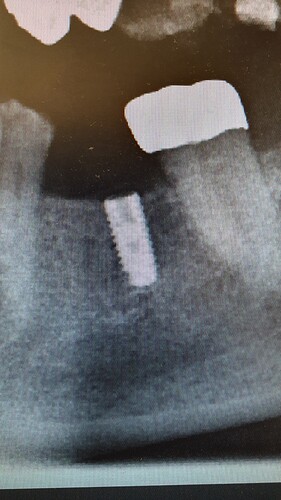Hello, I have a new patient that came in today with a fractured crown on implant. The initial panoramic x-ray was made 2 months ago, and the last 2 pictures today (the clinical crown fractured and the xray). What is the best practical solution for this case? It seems to me that the internal screw that fixes the crown in the implant is fractured with a portion of it that rests in the implant. I called the original doctor, and the implant is Axiom from Anthogyr.

frans-willem.janssens comments:
The buccal plate will fail, as well as the implant. The diameter of the implant is too large. Refer case to specialist for removal of the implant and bone grafting, then place a new implant, and then make sure you have enough bone circumferentially to get good osseintegration. Good luck.
Kaz Zymantas comments:
I am not quite sure how Dr. Pete can determine that the implant will fail. The diameter looks good to me but then I am not seeing a CT view. The position of the implant could be more mesial.
You can just remove the small threaded part of the screw and place a new screw and that is it. Make sure to adjust the occlusion well with no lateral interferences. Tell the patient that this is a prosthetic system and should be treated gently.
There should not be any force on the part of the screw in the implant so it can be removed using a long surgical length #1 round bur rotating in a counter clockwise manner. If you are not confident that you will not damage any threads, there is a device that attaches to a contra angle and it is a shaft with 2 prongs on the end that can engage the implant.
Kaz Zymantas comments:
that can engage the implant screw.
Kaz Zymantas comments:
A good synopsis of treatments possible but not complete.
dhmoose comments:
The internal connection of the abutment has fractured. To retrieve it, you'll have to expose the implant fixture (ie, remove soft tissue and achieve hemostasis) to visualize things well. Then, get a diamond bur that is the same diameter as the occlusal screw. Hand hold the diamond bur and insert it into the fractured piece and use the bur to engage and pull the fractured segment out. From the radiograph, there also appears to be a screw fragment to retrieve. This can be more difficult since the fragment is very deep within the fixture. An endo microscope can help but standard methods of screw retrieval can be utilized. I hope this helps.
-David Halmos, DMD, Prosthodontist
Mcwatson,dmd comments:
I have used a cotton swab to back out broken screws. Basically loosen the swab cotton so it’s “stringy” then insert the cotton down inside implant and twist counter clockwise. The cotton will grab the broken piece and twist out. Then restore that with a new custom abutment and crown. You have some options to take into account. Light to no occlusion, a mesial wing to rest on #20, or cement retained crown with temp cement(make the cement the weak link) I personally don’t like cement retained but in this case probably a good idea.
mwjdds, ms prosth comments:
the main issue is the mesial cantilever. This implant is replacing a first molar with strong occlusal forces. The screw most likely will break again. I agree with one commenter; how can Dr. Pete determine the buccal plate position? The forces will not break the buccal plate. Unfortunately the implant was placed too far distally causing a mesial cantilever and increasing the force to the screw.
Best way to remove a broken screw is with the Nobelbiocare screw removal tool. Simply gain access to the implant then use the screw removal tool, by hand, to back out the screw. It is similar to the poster that recommended the diamond bur trick (good idea!).
I remove about 3-4 broken screws a month for my colleagues and this removal tool is fantastic!
DoctorEd comments:
Situations like this are not uncommon. If you can somehow engage the abutment screw and remove it you will have an opportunity to start over with a new implant level impression, having a new custom abutment milled, and replacing the crown. If you are unable to remove the existing abutment screw hopefully you can engage the appropriate driver and reverse torque the implant. Most implants can be removed with counterclockwise torque applied with the appropriate driver. I have removed implants that have been successfully integrated for more than a year using this technique. The crown restoration on tooth #18 is failing from recurrent caries. Can #18 be "saved"? I think yes but it depends on successful endodontic treatment and successful placement of a core buildup and crown. Bacterial contamination of the endodontic treatment, bonding of the core buildup, and cementation of the crown can cause any of these steps to fail.
doclock comments:
Fractured screw. I have a very good endodontist who backs these out with ultrasonic scalers.


